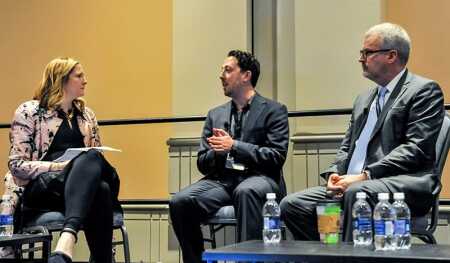U.S. retailers and their landlords are embracing the pop-up phenomenon in different ways to meet specific goals, speakers said at the 2016 ULI Spring Meeting in Philadelphia.
“Established brands are like that guy who keeps coming over to you at the cocktail party and telling you the same thing,” said panelist Greg Spielberg, founder of Imagination in Space, a New York City–based creative retail agency. But pop-up retail provides something that is always new and different, he said.
“A pop-up is a temporary activation that creates an expectation and delivers on it,” said Spielberg. “It allows consumers to see themselves reflected in the world around them.” For example, the company recently launched Goldmind, a pop-up concept store in Brooklyn’s trendy Williamsburg neighborhood featuring the work of young fashion, furniture, and lifestyle designers.
Phillip St. Pierre, senior managing director of the Seaport District for the Howard Hughes Corporation, described how Manhattan’s South Street Seaport is using pop-ups to reposition its property during a lengthy redevelopment process. “It’s not about who pays the rent but who’s coming next,” he said. “We are creating buzz and getting throngs of people to visit.”
South Street Seaport flourished in the 1980s as a festival marketplace that was a popular tourist attraction. After the location was heavily damaged by Hurricane Sandy in 2012, Hughes decided on an entirely new approach. As noted at the 2014 ULI Fall Meeting by project architect Gregg Pasquarelli of SHoP Architects, “Today no one would propose a three-story inward-focused building on the waterfront with a view of the Brooklyn Bridge. We want to create something transformational that will combine cultural, entertainment, dining, and emerging retail uses.”
Fast forward to the opening in summer 2015 of the pop-up Seaport Studios, a retailer that partners with independent brands representing contemporary style and invites them to showcase their designs in a curated retail space. Thousands of people have been attracted to the site by this eclectic mix of fashion, design, art, and food. As evidence of the project’s success, Hughes also recently signed long-term leases with the Michelin three-star restaurant Jean Georges as well as the popular Momofuku.
But pop-ups are appropriate for more than just shell space, outdoor markets, and properties undergoing redevelopment. Established brick-and-mortar stores are getting the message, panelists noted. This January, Macy’s opened its first Etsy shop, in its iconic Herald Square flagship store, featuring a curated selection of items from eight Etsy sellers in a dedicated retail space.
The Gap has brought in online subscription beauty products retailer Birchbox, and popular eyewear brand Warby Parker takes its pop-ups on the move in a converted school bus.
Celebrities, too, are jumping into the pop-up pool. Hundreds of New Yorkers lined up for entrance to a recent pop-up by Kanye West in SoHo, which reportedly sold $1 million worth of merchandise from West’s clothing line in just one weekend.
From a landlord’s perspective, hosting pop-ups is not for the faint of heart. “New designers have more talent than anything else,” said St. Pierre. “We take the lead role in helping them establish their shops, including marketing and public relations, to help them generate buzz.” Hughes partnered with a group called Pop-Up Mob to handle point-of-sale systems, customer interaction, security, and other functions. Creating buzz has entailed additional efforts through presentation of multiple events, such as movie nights, to attract visitors and customers.
Spielberg thinks of pop-ups as a “farm system” for up-and-coming retailers; often landlords provide free space and his agency engages in co-retailing with pop-up operators. “It may look like a loss leader, but it’s still real estate,” he noted. “You bring in the first tenants for free, and later you will see more retailers wanting to come in and pay for the space.”
While they may not be profitable in the short term, pop-ups have proven to be a highly successful way to help transform urban neighborhoods. In New York City, the Lower East Side’s Hester Street Fair became a proving ground for up-and-coming restaurants and first-time retailers, noted Spielberg. Pop-up retail also has helped turn around New York’s Meatpacking District; Abbot Kinney Boulevard in Venice, California; and Miami’s Wynwood neighborhood. In addition to curated retail offerings, pop-ups often include everything from art installations to yoga classes to food. In fact, said St. Pierre, “it seems we can’t have enough food—but it has to be good.”
“It’s a long game,” concluded St. Pierre. “Howard Hughes specializes in turnaround projects, and we see pop-ups being part of many projects. This concept can turn out-of-the-way spaces into destinations very quickly.”


